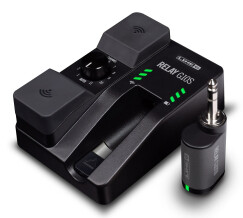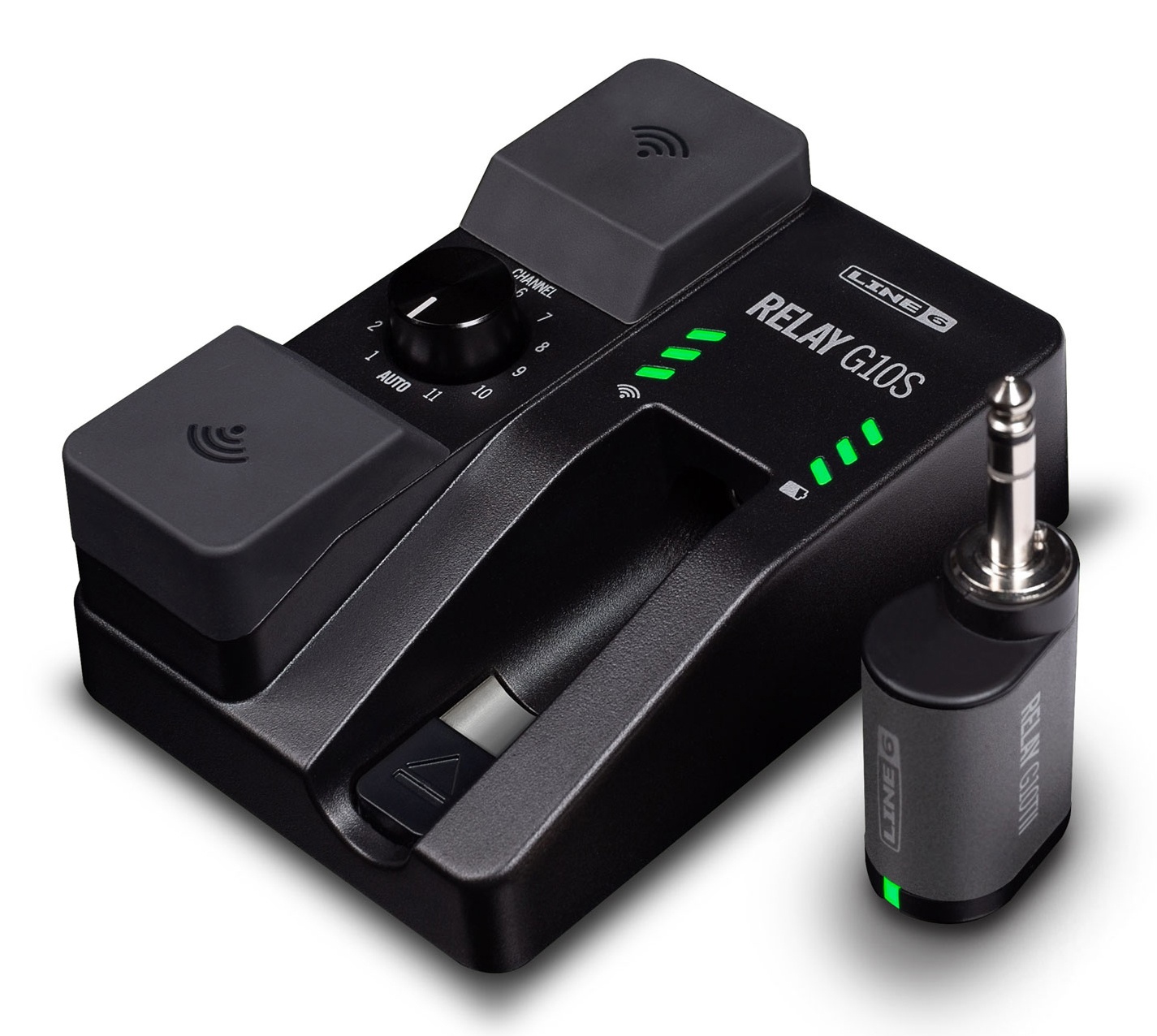Not satisfied with those reviews?
Filter
Our members also liked:
5.0/5(1 reviews)
100 %
Write a user review
Users reviews
 MGR/Brian Johnston
MGR/Brian JohnstonUnbelievable clarity that releases your tone
Published on 02/25/19 at 05:45SOUND:
The Relay G10S is a 2.4GHz wireless system for guitar (and other musical instruments) that produces (allows for) incredible tone because of its 24-bit uncompressed digital transmission (best in class ADC [analog to digital converter] and DAC [digital to analog converter] provide very low noise). Amazing clarity is the obvious first impression. The demo video accompanying this review demonstrates how to operate the Relay G10S, but there’s also a sound comparison, which very much surprised me.
I strummed some chords on a clean channel then later banged out a few riffs and double stops with s…Read moreSOUND:
The Relay G10S is a 2.4GHz wireless system for guitar (and other musical instruments) that produces (allows for) incredible tone because of its 24-bit uncompressed digital transmission (best in class ADC [analog to digital converter] and DAC [digital to analog converter] provide very low noise). Amazing clarity is the obvious first impression. The demo video accompanying this review demonstrates how to operate the Relay G10S, but there’s also a sound comparison, which very much surprised me.
I strummed some chords on a clean channel then later banged out a few riffs and double stops with some high gain. In both instances I compared two cable brands to the Relay G10S. The least expensive cable (of modest cost $25) was a Monster 12-foot. Next up was a quality 12-foot cable by Spectraflex, a company known in the industry for producing higher-end cables (and endorsed by many professional musicians). When compared to the G10S the Spectraflex cable was slightly darker and not as crisp and clean, whereas the Monster cable had an even more obvious darkness or muddiness to it. Now, what’s interesting about the G10S is that it offers a Cable Emulation function for both a 10-foot and 30-foot cable (I presume a sound difference becomes noticeable once you get upward of 30-feet). What this does is add an analog ‘warmth’ to the signal if you so choose such a setting, which can be beneficial if using bright pickups or amps. This, too, is demonstrated in the video.
OVERALL IMPRESSION:
The clarity of signal with the Relay G10S is nothing short of impressive. All my guitars, pedals, preamps, etc., actually sound better and slightly different… more crisp with a very apparent ‘cut-through-the-mix’ quality. At $249 USD it may seem steep for a wireless system that does nothing but transmit your guitar’s signal, but that is a typical cost for many pedals (and certainly a fraction of the price of a guitar, amp, etc.). Consequently, imagine having a pedal that enhances the sound of your music gear investment, and that’s exactly how the G10S should be viewed, besides having freedom from a chord wrapping around your feet. The Transmitter has a very fast charge of about 30-minutes, which then gives upward of 8-hours of play (by then your fingers will want a break). And if you leave your guitar for a short while and with the Transmitter plugged in, the Transmitter goes into sleep mode within 4-minutes to preserve battery life. With all all-steel construction, 130-feet of cable-free-freedom, auto channel select and a design made for a pedal board (although you can place it where preferred) there’s everything to like about Line 6’s Relay G10S and not much to gripe about. Wireless systems finally are getting to where high-end pedals have been for the past few years – excellent work by Line 6.
GENERAL USE:
Using the Relay G10S requires very little initial setup. The Transmitter (the part that plugs into your guitar) inserts into the Receiver for initial charging, which takes about a half-hour (which then gives upward of 8-hours of use). You can leave the Transmitter in storage when not in use, although you need to ‘press the Release Latch on the Receiver and pull the Transmitter out one stop so that the battery does not drain’ (fully inserted and the Transmitter communicates with the Receiver). If you leave the Transmitter in your guitar it will enter ‘sleep mode’ when there is no play for 4-minutes (the battery continues to drain, albeit more slowly). The Receiver has up to 11 possible channels from which to choose. Typically you would leave it on Auto so that the Receiver can search for the clearest channel with the least interference. However, if other band mates are using a wireless system you will need to select a Channel to prevent honing in on their territory and to keep their signals from interfering with your signal.
Both the Transmitter battery life and the Receiver (RF) signal strength can be viewed clearly on the Receiver (3 LEDs each, with ‘RF’ on the left and ‘battery life’ on the right). When you see 3 RF Green LEDs light up you have a strong signal, whereas 2 or 1 Green LEDs mean there is some strength, but not as good (and you cannot wander as far away before losing your signal). Red LEDs indicate anything from a usable or short range to too much interference. Having good reception (3 Green LEDs) means upward of 130-feet of freedom, just in case you want to stroll through an audience while playing. In regard to battery life, you get upward of 8-hours of play time on one charge, indicated by 3 Green LEDs. As you get down to only 1 Green LED you have about 1.5 hours, or a bit more, of charge. Red LEDs provide warning with 30-minutes or less of charge.
As indicated previously, there is a Cable Emulation option, to add analog warmth to the signal (since the G10S is so amazingly clear); a function that can be useful for bright amps and pickups – or perhaps you simply like a warmer tone relative to your gear. This function can be used only if you use the quarter-inch jack instrument out. The other ‘out’ option is the XLR DI Output that goes to a mixing desk, audio interface, etc. As well, there is a micro USB input for firmware updates and optional power.
OTHER DETAILS:
The Line 6 series of wireless systems have improved over the years. The Relay G10S has all metal construction, for both the Receiver and Transmitter. Past Receivers had a plastic housing and touring musicians had concerns about the long-term durability of the unit (I also have read this concern on various guitar forums). The antennae in the Receiver are protected by rubber pads as well, just in case your stomping foot goes awry. The unit is of standard pedal size, made for pedal board use, measuring approximately 5 (L) x 3.5 (w) x 2 (h) inches or 12.7 x 8.9 x 5 cm. The Transmitter tucks in nicely and well protected under the 2-inch height of the Receiver unit. All cable inputs and outputs are located in the back, which keeps a pedal board clean looking and cables out of the way. The Relay G10S (Receiver + Transmitter) comes with its own 500mA power supply, and you also get a USB cable if you prefer powering up in that manner, and certainly needed for firmware updates. As a side note, the Transmitter is a G10, which has existed prior to the G10S release. Consequently, if you have any G10 Transmitters you can use them in the updated Relay G10S system.
See less00






